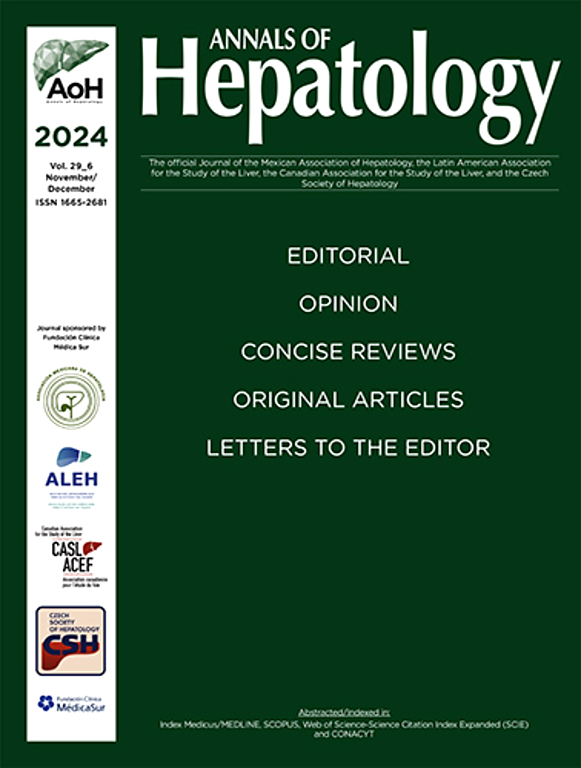Efficacy of prophylactic antibiotics in the adjuvant treatment of alcohol-related liver disease (ALD): A systematic review and meta-analysisProphylactic antibiotics in ALD
IF 3.7
3区 医学
Q2 GASTROENTEROLOGY & HEPATOLOGY
引用次数: 0
Abstract
Introduction and Objectives
This research aims to evaluate the efficacy and safety of prophylactic antibiotics in patients with alcohol-related liver disease (ALD).
Materials and Methods
We systematically searched databases including PubMed, Embase, Cochrane, and Web of Science up to October 2023. Our scope encompassed the influence of prophylactic antibiotics on all-cause mortality, infection, variceal bleeding, hepatic encephalopathy (HE), hepatorenal syndrome (HRS), adverse events (AE), fungal infection, clostridioides difficile infection (CDI), and multidrug-resistant (MDR) bacterial infection. Additionally, total bilirubin, creatinine, platelet counts, and plasma endotoxin levels were also analyzed.
Results
After comprehensive selection, 10 studies with 974 participants were included for further analysis. The study demonstrated that prophylactic antibiotic therapy was associated with reductions in infection rates, HE incidence, variceal bleeding, and all-cause mortality. The treatment did not increase the incidence of AE, fungal infection, and CDI, but it did raise the MDR bacteria infection rate. The analysis revealed no significant protective effect of antibiotic prophylaxis on total bilirubin and creatinine levels. Furthermore, the administration of antibiotics led to marginal increases in platelet counts, a minor reduction in endotoxin concentrations, and a subtle enhancement in HRS; however, these changes did not reach statistical significance.
Conclusions
Prophylactic antibiotic therapy was an effective and safe treatment for advanced ALD. To mitigate the risk of MDR bacterial infections, a strategy of selective intestinal decontamination could be advisable. Future investigations should prioritize varied ALD patient populations with extended follow-up periods and assorted antibiotic regimens to solidify the efficacy and safety of ALD treatments.
预防性抗生素在酒精相关性肝病(ALD)辅助治疗中的疗效:系统综述和荟萃分析预防性抗生素在酒精相关性肝病(ALD)中的应用。
引言和目的:本研究旨在评估预防性抗生素对酒精相关肝病(ALD)患者的疗效和安全性:我们系统地检索了截至 2023 年 10 月的数据库,包括 PubMed、Embase、Cochrane 和 Web of Science。我们的研究范围包括预防性抗生素对全因死亡率、感染、静脉曲张出血、肝性脑病(HE)、肝肾综合征(HRS)、不良事件(AE)、真菌感染、艰难梭菌感染(CDI)和耐多药(MDR)细菌感染的影响。此外,还分析了总胆红素、肌酐、血小板计数和血浆内毒素水平:结果:经过综合筛选,共有 10 项研究、974 名参与者被纳入进一步分析。研究表明,预防性抗生素治疗可降低感染率、高血压发病率、静脉曲张出血和全因死亡率。治疗并没有增加AE、真菌感染和CDI的发病率,但确实提高了MDR细菌的感染率。分析显示,抗生素预防对总胆红素和肌酐水平没有明显的保护作用。此外,服用抗生素可使血小板计数略有增加,内毒素浓度略有降低,HRS也有细微提高;但这些变化未达到统计学意义:结论:预防性抗生素治疗是一种有效、安全的晚期 ALD 治疗方法。为了降低MDR细菌感染的风险,选择性肠道净化策略是可取的。未来的研究应优先考虑不同的ALD患者群体,并延长随访时间和采用不同的抗生素治疗方案,以巩固ALD治疗的有效性和安全性。
本文章由计算机程序翻译,如有差异,请以英文原文为准。
求助全文
约1分钟内获得全文
求助全文
来源期刊

Annals of hepatology
医学-胃肠肝病学
CiteScore
7.90
自引率
2.60%
发文量
183
审稿时长
4-8 weeks
期刊介绍:
Annals of Hepatology publishes original research on the biology and diseases of the liver in both humans and experimental models. Contributions may be submitted as regular articles. The journal also publishes concise reviews of both basic and clinical topics.
 求助内容:
求助内容: 应助结果提醒方式:
应助结果提醒方式:


